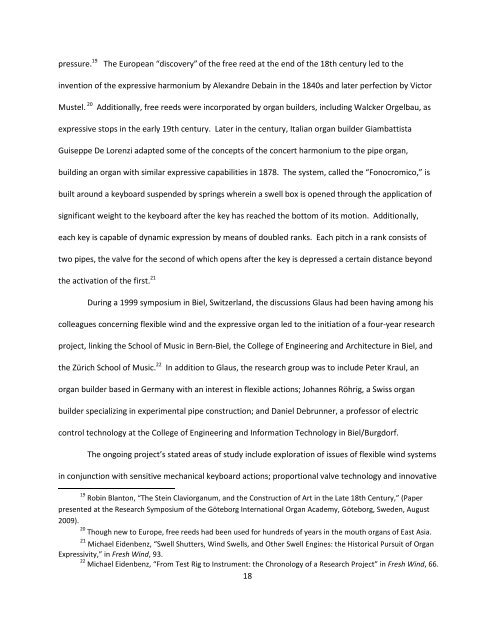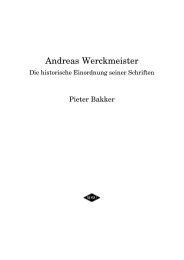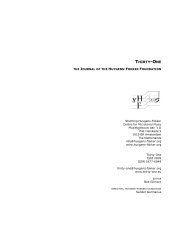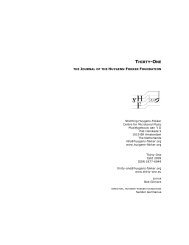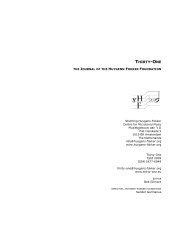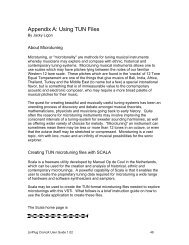Recent Organ Design Innovations and the 21st-century - Stichting ...
Recent Organ Design Innovations and the 21st-century - Stichting ...
Recent Organ Design Innovations and the 21st-century - Stichting ...
Create successful ePaper yourself
Turn your PDF publications into a flip-book with our unique Google optimized e-Paper software.
pressure. 19 The European “discovery” of <strong>the</strong> free reed at <strong>the</strong> end of <strong>the</strong> 18th <strong>century</strong> led to <strong>the</strong><br />
invention of <strong>the</strong> expressive harmonium by Alex<strong>and</strong>re Debain in <strong>the</strong> 1840s <strong>and</strong> later perfection by Victor<br />
Mustel. 20 Additionally, free reeds were incorporated by organ builders, including Walcker Orgelbau, as<br />
expressive stops in <strong>the</strong> early 19th <strong>century</strong>. Later in <strong>the</strong> <strong>century</strong>, Italian organ builder Giambattista<br />
Guiseppe De Lorenzi adapted some of <strong>the</strong> concepts of <strong>the</strong> concert harmonium to <strong>the</strong> pipe organ,<br />
building an organ with similar expressive capabilities in 1878. The system, called <strong>the</strong> “Fonocromico,” is<br />
built around a keyboard suspended by springs wherein a swell box is opened through <strong>the</strong> application of<br />
significant weight to <strong>the</strong> keyboard after <strong>the</strong> key has reached <strong>the</strong> bottom of its motion. Additionally,<br />
each key is capable of dynamic expression by means of doubled ranks. Each pitch in a rank consists of<br />
two pipes, <strong>the</strong> valve for <strong>the</strong> second of which opens after <strong>the</strong> key is depressed a certain distance beyond<br />
<strong>the</strong> activation of <strong>the</strong> first. 21<br />
During a 1999 symposium in Biel, Switzerl<strong>and</strong>, <strong>the</strong> discussions Glaus had been having among his<br />
colleagues concerning flexible wind <strong>and</strong> <strong>the</strong> expressive organ led to <strong>the</strong> initiation of a four-year research<br />
project, linking <strong>the</strong> School of Music in Bern-Biel, <strong>the</strong> College of Engineering <strong>and</strong> Architecture in Biel, <strong>and</strong><br />
<strong>the</strong> Zürich School of Music. 22 In addition to Glaus, <strong>the</strong> research group was to include Peter Kraul, an<br />
organ builder based in Germany with an interest in flexible actions; Johannes Röhrig, a Swiss organ<br />
builder specializing in experimental pipe construction; <strong>and</strong> Daniel Debrunner, a professor of electric<br />
control technology at <strong>the</strong> College of Engineering <strong>and</strong> Information Technology in Biel/Burgdorf.<br />
The ongoing project’s stated areas of study include exploration of issues of flexible wind systems<br />
in conjunction with sensitive mechanical keyboard actions; proportional valve technology <strong>and</strong> innovative<br />
19 Robin Blanton, “The Stein Claviorganum, <strong>and</strong> <strong>the</strong> Construction of Art in <strong>the</strong> Late 18th Century,” (Paper<br />
presented at <strong>the</strong> Research Symposium of <strong>the</strong> Göteborg International <strong>Organ</strong> Academy, Göteborg, Sweden, August<br />
2009). 20 Though new to Europe, free reeds had been used for hundreds of years in <strong>the</strong> mouth organs of East Asia.<br />
21<br />
Michael Eidenbenz, “Swell Shutters, Wind Swells, <strong>and</strong> O<strong>the</strong>r Swell Engines: <strong>the</strong> Historical Pursuit of <strong>Organ</strong><br />
Expressivity,” in Fresh Wind, 93.<br />
22<br />
Michael Eidenbenz, “From Test Rig to Instrument: <strong>the</strong> Chronology of a Research Project” in Fresh Wind, 66.<br />
18


